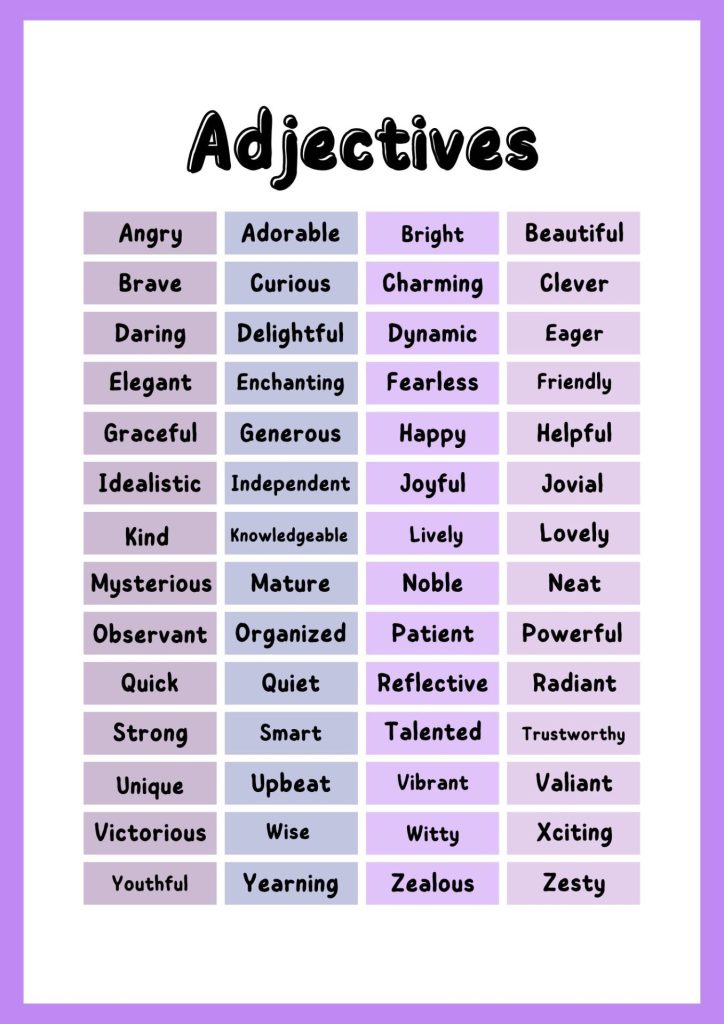What is an Adjective? – Meaning, Types & Example
Table of Contents
Introduction
Adjectives
In the realm of language and grammar, adjectives play a crucial role in adding depth, description, and detail to our communication. From simple sentences to complex narratives, adjectives enhance our ability to express emotions, characteristics, and qualities. Let’s delve into the fascinating world of adjectives and uncover their significance in language.
Analogy of Definition
What is an Adjective?
Adjectives are words that modify or describe nouns and pronouns. They provide information about the size, shape, color, age, and more, of the noun or pronoun they are referring to. By using adjectives, we can paint a vivid picture and create a more engaging and descriptive language. It is one of the eight parts of speech.
Method
Types of Adjectives
1. Possessive Adjectives
These adjectives indicate ownership or possession, such as “my,” “your,” “his,” “her,” “its,” “our,” and “their.”
2. Demonstrative Adjectives
These adjectives point out specific things, such as “this,” “that,” “these,” and “those.”
3. Coordinating Adjectives
These adjectives work together to modify the same noun, such as “big, red, and round.”
4. Interrogative Adjectives
These adjectives are used to ask questions about nouns, such as “which,” “what,” and “whose.”
5. Attributive Adjectives
These adjectives directly modify the noun they are describing, such as “beautiful” in “beautiful flowers.”
6. Compound Adjectives
These adjectives are formed by combining two or more words to create a single adjective, such as “well-known,” “high-speed,” and “blue-eyed.”

Using Adjectives in a Sentence
Using adjectives in a sentence allows us to provide more detail and create a more vivid image in the reader’s mind. For example, instead of saying “She wore a dress,” we can say “She wore a beautiful, flowing dress.” The addition of the adjectives “beautiful” and “flowing” paints a clearer picture of the dress and enhances the overall description.
Degree of Adjectives
1. Absolute Adjectives
These adjectives do not compare one thing with another and simply describe the quality of the noun, such as “perfect,” “complete,” and “unique.”
Example: She is always happy.
2. Comparative Adjectives
These adjectives are used to compare two things and often end in “-er” or use “more” or “less” before the adjective, such as “faster,” “slower,” “more beautiful,” and “more intelligent.”
Example: He seems to be happier today than yesterday.
3. Superlative Adjectives
These adjectives are used to compare three or more things and often end in “-est” or use “most” before the adjective, such as “fastest,” “slowest,” “most beautiful,” and “most intelligent.”
Example: Among all her friends, she is the happiest person.
Examples
1. Possessive Adjectives
- My cat is sleeping on your bed.
- The children love playing with their toys.
2. Demonstrative Adjectives
- This book is fascinating.
- Those birds are singing beautifully.
3. Coordinating Adjectives:
-
- The room was filled with big, red, and round balloons.
- She wore a long, flowing, and elegant dress.
4. Interrogative Adjectives:
-
-
- Which movie do you want to watch?
- Whose backpack is on the chair?
-
5. Attributive Adjectives:
- The garden is full of beautiful flowers.
- The team played with intense determination.
6. Compound Adjectives:
- It was a well-known fact.
- The high-speed train zoomed past.
Quiz
Tips and Tricks
1. Possessive Adjectives
Tip: Possessive adjectives indicate ownership or possession. Common examples include my, your, his, her, its, our, and their. They are usually found before the noun they modify.
2. Interrogative Adjectives
Tip: Interrogative adjectives are used in questions to gain more information about a noun. Common examples include which, what, and whose. These adjectives are often followed by a noun.
3. Coordinating Adjectives
Tip: Identify multiple adjectives that are working together to modify the same noun. Coordinating adjectives are separated by commas, and they can often be rearranged without changing the meaning.
4. Attributive Adjectives
Tip: These adjectives directly modify the noun they describe, providing essential information. Attributive adjectives can be removed from the sentence, and the sentence still makes sense. For example, “The beautiful flowers are in the garden” can be simplified to “The flowers are in the garden.”
5. Compound Adjectives
Tip: Look for adjectives formed by combining two or more words. Compound adjectives are often hyphenated and can include combinations of words like well-known, high-speed, or blue-eyed.
Real life application
Story: “The Power of Adjectives in Everyday Life”
In everyday life, adjectives play a significant role in shaping our perceptions, interactions, and experiences. Let’s explore how adjectives come into play in various real-life scenarios.
Scenario 1: The Job Interview
During a job interview, using positive adjectives to describe your skills and experiences can leave a lasting impression on the interviewer. Phrases such as “dedicated team player,” “innovative problem-solver,” and “effective communicator” can showcase your strengths and capabilities.
Scenario 2: The Product Description
When writing product descriptions for e-commerce websites, using descriptive adjectives can entice potential buyers and create a sense of desire. Words like “luxurious,” “versatile,” and “sleek” can paint a compelling picture of the product and influence purchasing decisions.
Scenario 3: The Travel Experience
In travel blogs and reviews, adjectives are used to vividly describe destinations, experiences, and accommodations. Terms like “breathtaking scenery,” “charming cafes,” and “serene beaches” can transport readers to the locations and evoke a sense of wanderlust.
Scenario 4: The Culinary Delight
In the world of food and dining, adjectives are essential for conveying the flavors, textures, and presentations of dishes. Descriptions such as “succulent grilled chicken,” “crispy golden fries,” and “decadent chocolate cake” can tantalize the taste buds and create a sensory experience.
Scenario 5: The Artistic Expression
Artists and creatives use adjectives to convey emotions, moods, and themes in their work. Terms like “expressive brushstrokes,” “vibrant color palette,” and “evocative storytelling” can capture the essence of artistic pieces and resonate with viewers on a deeper level.
FAQ's
Like? Share it with your friends






